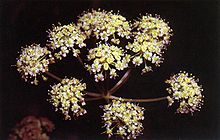- Cicuta douglasii
-
Cicuta douglasii 
Scientific classification Kingdom: Plantae (unranked): Angiosperms (unranked): Eudicots (unranked): Asterids Order: Apiales Family: Apiaceae Genus: Cicuta Species: C. douglasii Binomial name Cicuta douglasii
(DC.) Coult. & RoseCicuta douglasii (Western water hemlock) is a poisonous plant in the family Apiaceae. It is a perennial plant that grows in wet places such as marshes, stream banks, slough margins, ditches, meadows, and wet pastures[1][2]. The roots of this plant are thick and tuberous, with many smaller tubers coming from the main tuber[3]. This root structure allows the water hemlock to adapt and survive wet conditions. Water hemlock is most abundant in British Columbia[1], and is indigenous to North America[3]. In North America it primarily grows from the base of the Rocky Mountains to the Pacific coast, stretching all the way from Alaska down to California. Water necessities limit this plant from growing in open rangelands[3].
The characteristics of water hemlock include its stem which is 0.5–2 meters tall with purplish spots, thick roots, and leaves that are compound pinnate and alternate[2]. The leaflets are usually 5–8 cm long and 1–2 cm wide with jagged edges[3]. The flowers on it are compound umbellate inflorescences with many small, white flowers[3]. There are two seeds for each flower. Seed dispersal for water hemlock seeds comes from means of wind, water, machinery, on clothing, and through transported soil[1]. The seeds germinate in spring, and flowers mature near the end of June and beginning of July[3]. In addition to sprouting new plants from seeds, rootstocks can also product new plants. These are formed in the fall from the basal meristem, and when they detach the following spring, they may form a new plant.
Toxicity
Main article: Cicuta toxicityThe main distinguishable characteristic of western water hemlock is its toxicity. Cicutoxin is the toxin that is produced by the water hemlock, making it the most poisonous plant in North America.[4] Cicutoxin is a yellowish liquid that is prevalent in the roots. It is an unsaturated alcohol that has a major impact on the central nervous system of animals. Early symptoms of cicutoxin poisoning include excessive salivation, frothing at the mouth, nervousness, and incoordination. These symptoms can turn into tremors, muscular weakness, seizures and respiratory failure.[3] Very small amounts of green materials of W. water hemlock, about .1% of a person’s body weight can even lead to death[5]. In addition to being extremely dangerous to humans, this plant has an enormous impact on animals. It is one of the first plants to come out in springtime, and has a very appealing odor[3]. As little as 0.2%-0.5% body weight for sheep, 0.1% body weight for cattle, 0.5% body weight for horses, and 0.3% body weight for swine can be lethal. Death can occur within fifteen minutes of ingesting this toxin. These characteristics, along with the fact that it grows in moist areas make it a very desirable, yet deadly, plant for grazing animals.
Similar species
These plants all have white flowers in large compound umbels. Therefore, Cicuta douglasii may be confused with water parsnip and swamp parsnip, sium suave). Water parsnip and water hemlock both have cluster of small white flowers shaped like umbrellas, and both have the same habitat near the shore line of lakes, and rivers. Water parsnip has leaves only once compound, and water hemlock has leaves which are three times compound. Water hemlock has a large swelling at the stem base. C. douglasii is highly poisonous.[6] Water parsnip is not poisonous.[7] The water hemlock has bracts at the base of each small flower cluster, not at the base of the main flower head.[8] The Water parsnip has small bracts at the base of flowers and main flower head as well.[9] The Yarrow, (Common Yarrow, Gordaldo, Nosebleed plant, Old Man's Pepper, Sanguinary, Milfoil, Soldier's Woundwort, Thousand-leaf (as its binomial name affirms), Thousand-seal or Achillea millefolium) also has many small white flowers in a cluster. However the yarrow has feathery looking leaves which are pinnately separated into small narrow segments.[10] The cow parsnip (heracleum lanatum, Heracleum maxinium Indian Celery or Pushki, and Heracleum sphondylium, hogweed) is also confused in this group with similar flower groupings. However, the cow parsnip has large, broad leaves, and an unpleasant odour.[11]
Footnotes
- ^ a b c Weeds BC (2005-07-13). "Water hemlock, Cicuta douglasii". http://www.weedsbc.ca/weed_desc/water_hem.html.
- ^ a b Saskatchewan Agriculture and food (2005-07-13). "Western water hemlock". http://www.agr.gov.sk.ca/DOCS/crops/integrated_pest_management/weed_identification_broadleaf_weeds/whemlock.asp.
- ^ a b c d e f g h Block, N. (n.d.). (2005-07-13). "Cicuta douglasii (DC.) Coult. & Rose". http://www.usask.ca/agriculture/plantsci/classes/range/cicuta.html.
- ^ Schep LJ, Slaughter RJ, Becket G, Beasley DM (April 2009). "Poisoning due to water hemlock". Clin Toxicol (Phila) 47 (4): 270–8. doi:10.1080/15563650902904332. PMID 19514873.
- ^ Ministry of agriculture, food & fisheries (2005-07-13). "Western water hemlock". http://www.agf.gov.bc.ca/cropprot/whemlock.htm.
- ^ "Cicuta maculata.". http://www.em.ca/garden/native/nat_cicuta_maculata.html. Retrieved 2008-08-03.[dead link]
- ^ Traditional Plant Foods of Canadian Indigenous Peoples By Harriet V Kuhnlein, Nancy J.. 1991. ISBN 9782881244650. http://books.google.com/?id=fPDErXqH8YYC&pg=PA124&lpg=PA124&dq=hemlock++saskatchewan#PPA124,M1. Retrieved 2008-08-03.
- ^ "Western Water Hemlock - Agriculture - Government of Saskatchewan". http://www.agriculture.gov.sk.ca/Default.aspx?DN=6896bcb3-d202-43e0-ace9-c4ec72d8835d. Retrieved 2008-08-03.
- ^ "Water Parsnip - Agriculture - Government of Saskatchewan". http://www.agriculture.gov.sk.ca/Default.aspx?DN=e2b0945b-6609-4790-ae82-8fdd9135af26. Retrieved 2008-08-03.
- ^ "Yarrow Achillea millefolium". http://www.em.ca/garden/native/nat_Achillea%20millefolium.html. Retrieved 2008-08-03.
- ^ "Heracleum lanatum". University of Saskatchewan. http://www.usask.ca/agriculture/plantsci/classes/range/heracleum.html. Retrieved 2008-08-03.
Categories:
Wikimedia Foundation. 2010.
